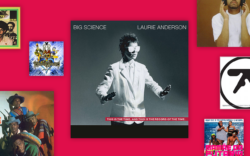Filter house originated in the mid ’90s in France, with labels such as Roulé and the lesser-known (but equally great) Crydamoure.
Filter house is closely related to French house, and sometimes these terms are even used interchangeably. In ways, the genre can be seen as an evolution of the early Chicago house sound that was based on sampled loops from disco, boogie, and funk records. We can also draw a parallel to early hip hop, which used similar sampling techniques and hardware.
Filter house’s key innovators
Thomas Bangalter (half of Daft Punk and the head of Roulé) was a key figure in the emergence of the filter house sound. His track “Music Sounds Better with You,” released in collaboration with DJ Alan Braxe and vocalist Benjamin Diamond under his ‘Stardust’ alias, was a big hit that put filter (and French) house on the map.
Other French artists that contributed to the rise of the genre include the likes of Modjo, Étienne De Crécy, Motorbass, and Le Knight Club. Meanwhile, in America you had artists like DJ Sneak, Paul Johnson, and Mike Delgado releasing their own take on the sound. Duck Sauce is another more contemporary force that’s incorporating elements of filter house into their music.
Filter house’s ingredients
The main ingredient of a filter house track is a sampled loop (usually two – four bars) from a disco or funk record, or an original loop that draws heavy inspiration from disco samples (which is often preferable to avoid copyright issues). The phrase is often repeated for the entire duration of the track, with timbral variations made possible by filtering and other related effects like phasing and flanging.
The sample can also be edited and cut up in different ways, and it’s also common to repeat different parts of the loop to create even more variation. In the drum department, dirty 909-type drums are often featured with plenty of shuffle and swing. For possible supplementary instrumentation, electric bass, guitar, and electric pianos are often incorporated (synths are sometimes used as well).
Tips for creating filter house tracks
If you’re interested in producing your own filter house tracks, below are a few tips you might want to keep in mind.
- Lean into minimalism. Filter house tracks are often not much more than one disco loop with drums added on top. You tell the story by creatively manipulating these few elements.
- Embrace ‘imperfections.’ Don’t be afraid to keep your sounds relatively raw and organic, instead of cleaning them up too much with EQ. Noise, dust, saturation, and distortion are part of the charm (along with liberal amounts of compression, of course).
- Know the tools. The hardware samplers that artists used back in the day to record and play back sounds play a large role in shaping the genre’s sound. Old machines like E-mu’s SP-1200 gave tracks some extra grit and a very specific timbre due to their reduced fidelity. To save precious memory and sampling time, often a loop from vinyl was recorded to the SP-1200 at 45 rpm, and then pitched down to the right speed in the sampler, which caused a lot of juicy artifacts to appear. If you don’t have access to hardware samplers, you can approximate this effect by using bitcrushers or plugins that specifically try to emulate a vintage sampler like XLN Audio’s RC-20.
The combination of disco and funk grooves gives filter house a distinctive and appealing sound. Take a listen to our demo track that captures the essence of filter house below, and if you’re interested in exploring the individual samples that make up the sound firsthand, check out Sample Magic’s “Filter House” sample pack.
What genre do you want to see us dive into next? Let us know in the comments below.
Dive into the building blocks of filter house and incorporate them into your own productions:
December 18, 2020

.svg)
.svg)




